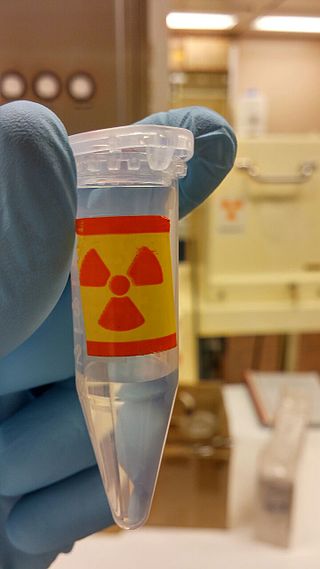Related Research Articles

Positron emission tomography (PET) is a functional imaging technique that uses radioactive substances known as radiotracers to visualize and measure changes in metabolic processes, and in other physiological activities including blood flow, regional chemical composition, and absorption. Different tracers are used for various imaging purposes, depending on the target process within the body.

Single-photon emission computed tomography is a nuclear medicine tomographic imaging technique using gamma rays. It is very similar to conventional nuclear medicine planar imaging using a gamma camera, but is able to provide true 3D information. This information is typically presented as cross-sectional slices through the patient, but can be freely reformatted or manipulated as required.

Nuclear medicine, or nucleology, is a medical specialty involving the application of radioactive substances in the diagnosis and treatment of disease. Nuclear imaging is, in a sense, radiology done inside out, because it records radiation emitted from within the body rather than radiation that is transmitted through the body from external sources like X-ray generators. In addition, nuclear medicine scans differ from radiology, as the emphasis is not on imaging anatomy, but on the function. For such reason, it is called a physiological imaging modality. Single photon emission computed tomography (SPECT) and positron emission tomography (PET) scans are the two most common imaging modalities in nuclear medicine.
A radioligand is a microscopic particle which consists of a therapeutic radioactive isotope and the cell-targeting compound - the ligand. The ligand is the target binding site, it may be on the surface of the targeted cancer cell for therapeutic purposes. Radioisotopes can occur naturally or be synthesized and produced in a cyclotron/nuclear reactor. The different types of radioisotopes include Y-90, H-3, C-11, Lu-177, Ac-225, Ra-223, In-111, I-131, I-125, etc. Thus, radioligands must be produced in special nuclear reactors for the radioisotope to remain stable. Radioligands can be used to analyze/characterize receptors, to perform binding assays, to help in diagnostic imaging, and to provide targeted cancer therapy. Radiation is a novel method of treating cancer and is effective in short distances along with being unique/personalizable and causing minimal harm to normal surrounding cells. Furthermore, radioligand binding can provide information about receptor-ligand interactions in vitro and in vivo. Choosing the right radioligand for the desired application is important. The radioligand must be radiochemically pure, stable, and demonstrate a high degree of selectivity, and high affinity for their target.
A gallium scan is a type of nuclear medicine test that uses either a gallium-67 (67Ga) or gallium-68 (68Ga) radiopharmaceutical to obtain images of a specific type of tissue, or disease state of tissue. Gallium salts like gallium citrate and gallium nitrate may be used. The form of salt is not important, since it is the freely dissolved gallium ion Ga3+ which is active. Both 67Ga and 68Ga salts have similar uptake mechanisms. Gallium can also be used in other forms, for example 68Ga-PSMA is used for cancer imaging. The gamma emission of gallium-67 is imaged by a gamma camera, while the positron emission of gallium-68 is imaged by positron emission tomography (PET).

Neuroendocrine tumors (NETs) are neoplasms that arise from cells of the endocrine (hormonal) and nervous systems. They most commonly occur in the intestine, where they are often called carcinoid tumors, but they are also found in the pancreas, lung, and the rest of the body.

Nuclear pharmacy, also known as radiopharmacy, involves preparation of radioactive materials for patient administration that will be used to diagnose and treat specific diseases in nuclear medicine. It generally involves the practice of combining a radionuclide tracer with a pharmaceutical component that determines the biological localization in the patient. Radiopharmaceuticals are generally not designed to have a therapeutic effect themselves, but there is a risk to staff from radiation exposure and to patients from possible contamination in production. Due to these intersecting risks, nuclear pharmacy is a heavily regulated field. The majority of diagnostic nuclear medicine investigations are performed using technetium-99m.

EF5 is a nitroimidazole derivative used in oncology research. Due to its similarity in chemical structure to etanidazole, EF5 binds in cells displaying hypoxia.
Copper-64 (64Cu) is a positron and beta emitting isotope of copper, with applications for molecular radiotherapy and positron emission tomography. Its unusually long half-life (12.7-hours) for a positron-emitting isotope makes it increasingly useful when attached to various ligands, for PET and PET-CT scanning.
Perfusion is the passage of fluid through the lymphatic system or blood vessels to an organ or a tissue. The practice of perfusion scanning is the process by which this perfusion can be observed, recorded and quantified. The term perfusion scanning encompasses a wide range of medical imaging modalities.
Nuclear medicine physicians, also called nuclear radiologists or simply nucleologists, are medical specialists that use tracers, usually radiopharmaceuticals, for diagnosis and therapy. Nuclear medicine procedures are the major clinical applications of molecular imaging and molecular therapy. In the United States, nuclear medicine physicians are certified by the American Board of Nuclear Medicine and the American Osteopathic Board of Nuclear Medicine.

DOTA-TATE is an eight amino acid long peptide, with a covalently bonded DOTA bifunctional chelator.

Positron emission tomography–magnetic resonance imaging (PET–MRI) is a hybrid imaging technology that incorporates magnetic resonance imaging (MRI) soft tissue morphological imaging and positron emission tomography (PET) functional imaging.

18F-FMISO or fluoromisonidazole is a radiopharmaceutical used for PET imaging of hypoxia. It consists of a 2-nitroimidazole molecule labelled with the positron-emitter fluorine-18.
Sandip Basu is an Indian physician of Nuclear Medicine and the Head, Nuclear Medicine Academic Program at the Radiation Medicine Centre. He is also the Dean-Academic (Health-Sciences), BARC at Homi Bhabha National Institute and is known for his services and research in Nuclear Medicine, particularly on Positron emission tomography diagnostics and Targeted Radionuclide Therapy in Cancer. The Council of Scientific and Industrial Research, the apex agency of the Government of India for scientific research, awarded him the Shanti Swarup Bhatnagar Prize for Science and Technology, one of the highest Indian science awards for his contributions to Nuclear Medicine in 2012.

Peptide receptor radionuclide therapy (PRRT) is a type of radionuclide therapy, using a radiopharmaceutical that targets peptide receptors to deliver localised treatment, typically for neuroendocrine tumours (NETs).
Nuclear Medicine Communications is an official journal of the British Nuclear Medicine Society based in Nottingham, United Kingdom. The journal publishes studies based on radionuclide imaging for basic, preclinical, and clinical research. Areas of interest include radiochemistry, radiopharmacy, radiobiology, radiopharmacology, medical physics, computing and engineering, and technical and nursing professions involved in delivering nuclear medicine services.
The British Nuclear Medicine Society (BNMS) was established in 1966 and is an independent forum devoted to various aspects of nuclear medicine in the UK. The mission statement of BNMS is "the advancement of science and public education in Nuclear Medicine that would benefit patients." As of 2020 the BNMS has over 600 members. The BNMS is a registered company and charity.
Sally Barrington is a professor of positron emission tomography (PET) Imaging and National Institute for Health Research (NIHR) research professor at King's College London (KCL), England, United Kingdom. She joined KCL in 1993.
Theranostics, also known as theragnostics, is a technique commonly used in personalised medicine. For example in nuclear medicine, one radioactive drug is used to identify (diagnose) and a second radioactive drug is used to treat (therapy) cancerous tumors. In other words, theranostics combines radionuclide imaging and radiation therapy which targets specific biological pathways.
References
- 1 2 "UCLH website". Archived from the original on 5 June 2020.
- ↑ "LWW website".
- ↑ "UCLH News". Archived from the original on 5 June 2020.
- ↑ "Prnewswire website" (Press release).
- ↑ "Biospace website".
- ↑ "Eurekalert website".
- ↑ Hoskin, Peter J. (2007). Radiotherapy in practice : radioisotope therapy. Oxford University Press. ISBN 978-0-19-176878-1. OCLC 906032566.
- ↑ Bomanji, Jamshed. (1987). Tissue characterization : using 123ı-metaiobenzylguanidine and 99m Tc monoclonal antibody (223.28s) fragments. University of London. OCLC 17924070.
- ↑ Mansi, Luigi, Herausgeber. Lopci, Egesta, Herausgeber. Cuccurullo, Vincenzo, Herausgeber. Chiti, Arturo, Herausgeber. (2 November 2015). Clinical Nuclear Medicine in Pediatrics. ISBN 978-3-319-21371-2. OCLC 941397753.
{{cite book}}: CS1 maint: multiple names: authors list (link) - ↑ Fraioli, Francesco Herausgeber. (5 March 2019). PET/CT in Brain Disorders. ISBN 978-3-030-01523-7. OCLC 1091713200.
- ↑ McCready, Ralph. Gnanasegaran, Gopinath. Bomanji, Jamshed B. (2016). A History of Radionuclide Studies in the UK 50th Anniversary of the British Nuclear Medicine Society. Springer International Publishing. ISBN 978-3-319-28624-2. OCLC 955942471.
{{cite book}}: CS1 maint: multiple names: authors list (link) - ↑ "Scopus website".